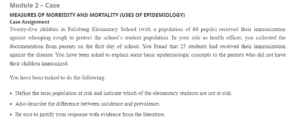Measures of Morbidity and Mortality
Epidemiology broadly refers to the study of occurrence, distribution, and potential control, and risk factors related to health. As such, the discipline of epidemiology depends on the unbiased and systematic gathering, assessment, and interpretation of information about a given population, with the purpose of assessing the causes, risk factors, prevention, and treatment of particular health conditions (Timmreck, 2002). Therefore, epidemiologists primarily focus on analyzing injury and disease patterns among different populations. They often strive to lower the incidence, prevalence, and risk of diseases and injury through health policy, community education, as well as research. Therefore, some of the key terms critical to epidemiological studies include incidence, prevalence, and at-risk populations.
Define the term population at risk and indicate which of the elementary students are not at risk.
The term’ population at risk is commonly used in epidemiology to refer to the number of people/population/groups that are susceptible to the incident/episode of interest (such as death, disease, or infection) at a specifically defined timeframe (Minnesota Department of Health, n.d.; Simarro et al., 2012). In simple terms, the ‘at-risk population’ refers to the subgroup or group that is more sensitive or seems to stand a higher chance of exposure to a particular disease/substance/event than the general population (National Research Council et al., 2007). It is often used as the denominator when calculating prevalence and incidence rates of events, such as disease. Usually, the exact numbers of people that truly experience the outcome or event comprise the numerator.
For example, in the instance of Fallsburg Elementary School, the population at risk of contracting whooping cough is 35 students that were never given the whooping cough immunization. This group stands the highest chance of suffering from whooping cough because they have not been vaccinated.
Also describe the difference between incidence and prevalence.
Prevalence and incidence are two terms that are often used mistakenly and interchangeably (Gerstman, 2003). The two terms bear the same definition but with a slight difference. Prevalence refers to the exact number of disease cases that exist in a specific population at a particular timeframe. In contrast, incidence refers to the number of new instances/cases reported during a particular period (Kenneth, 2012). In simple terms, prevalence is used to answer the question, “How many individuals have this condition right now?” On the contrary, the incidence is used to answer the question, “How many individuals have acquired the condition during the entire period?”
The word “incidence rate” refers to the frequency at which a new illness, disease, or any other event occurs over a particular timescale. An incidence proportion, conversely, refers to the number of new incidences/cases reported within a particular timeframe subdivided by the total population first reported to be at risk. For instance, in the example of Fallsburg Elementary School, if three students of the 35 that were not vaccinated get the whooping cough disease within a day, then the incidence rate is 2/35 by 100 percent per day. The incidence rate, therefore, is 5.7 percent per day. On the other hand, if a total of 20 students have so far contracted the disease since the first day it was reported (for instance, for now, one year), then the prevalence rate is 20/35 by 100 per year. As a percentage, the prevalence rate is 57.1 percent per year.
References
Gerstman, B.B. (2003). Epidemiology Kept Simple: An Introduction to Traditional and Modern Epidemiology (2nd ed.). Hoboken, NJ: Wiley-Liss.
Kenneth J. R. (2012). Epidemiology: An Introduction. Oxford University Press.
Minnesota Department of Health. (n.d.). Defining “at-risk” populations. Retrieved from https://www.health.state.mn.us/communities/ep/afn/atriskdef.html
National Research Council, et al. (2007). Tools and methods for estimating populations at risk from natural disasters and complex humanitarian crises. National Academies Press.
Simarro, P. P., et al. (2012). Estimating and mapping the population at risk of sleeping sickness. Plos Neglected Tropical Diseases, 6(10), 21859. doi: 10.1371/journal.pntd.0001859
Timmreck, T. C. (2002). An introduction to epidemiology. Jones & Bartlett Learning.
ORDER A PLAGIARISM-FREE PAPER HERE
We’ll write everything from scratch
Question
Module 2 – Case
MEASURES OF MORBIDITY AND MORTALITY (USES OF EPIDEMIOLOGY)
Case Assignment

Measures of Morbidity and Mortality
Twenty-five children in Fallsburg Elementary School (with a population of 60 pupils) received their immunization against whooping cough to protect the school’s student population. In your role as health officer, you collected the documentation from parents on the first day of school. You found that 25 students had received their immunization against the disease. You have been asked to explain some basic epidemiologic concepts to the parents who did not have their children immunized.
You have been tasked to do the following:
- Define the term population at risk and indicate which of the elementary students are not at risk.
- Also describe the difference between incidence and prevalence.
- Be sure to justify your response with evidence from the literature.
Length: 2–3 pages, excluding title page and references.
Assignment Expectations
Assessment and Grading: Your paper will be assessed based on the performance assessment rubric. You can view it under Assessments at the top of the page. Review it before you begin working on the assignment. Your work should also follow these Assignment Expectations.

